Mary Cronk Farrell's Blog, page 12
March 4, 2016
Guess Who Won the Civil War Battle between Doctors & Nurses...
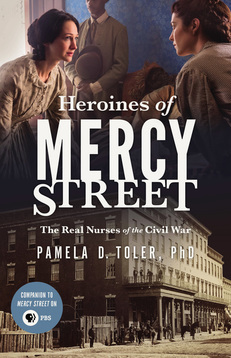
Pamela D. Toler, author of a new book about the agreed to talk to me about the book, and right off, I told her I tend to be queasy.
She assured me the book touches lightly on the blood and gore of battle wounds, and focuses on the doggedness of the women nurses.
Doggedness they sorely needed because the doctors didn't want their help.
Pamela says ""Just getting to the hospital or battlefield required these women to push against societies assumptions about what ladies should and should not do.
Georgeanna Woolsey was a New York socialite who took all the trimming off one of her dresses and a bonnet, dressed her hair as plainly as possible and, to the amazement of her family, bluffed her way into a slot in the nurses training program."
 Civil War Nurses, Fredericksburg, Virginia. Library of Congress
Civil War Nurses, Fredericksburg, Virginia. Library of Congress
 Georgeanna Woolsey wrote, "No one knows who did not watch the thing from the beginning, how much opposition, how much ill-will, how much unfeeling want of thought, these women nurses endured. Hardly a surgeon whom I can think of received or treated them with even common courtesy. Government had decided that women should be employed, and the Army surgeons - unable therefore to close the hospitals against them - determined to make their lives so unbearable that they should be forced in self-defense to leave."
Georgeanna Woolsey wrote, "No one knows who did not watch the thing from the beginning, how much opposition, how much ill-will, how much unfeeling want of thought, these women nurses endured. Hardly a surgeon whom I can think of received or treated them with even common courtesy. Government had decided that women should be employed, and the Army surgeons - unable therefore to close the hospitals against them - determined to make their lives so unbearable that they should be forced in self-defense to leave."  Savage Station, Virginia. Union field hospital after the battle of June 27 Includes the straw-hatted Sixteenth New York Infantry who fought at Gaines' Mill on June 27. Most were captured when Confederates overtook the area during the battle of Savage's Station on June 29 during the Peninsular Campaign. Library of Congress Pamela says the nurses "learned to cope with the sights and smells of a military hospital—dysentery and amputations were both ugly things. Some women didn't last. And I can't blame them.
Savage Station, Virginia. Union field hospital after the battle of June 27 Includes the straw-hatted Sixteenth New York Infantry who fought at Gaines' Mill on June 27. Most were captured when Confederates overtook the area during the battle of Savage's Station on June 29 during the Peninsular Campaign. Library of Congress Pamela says the nurses "learned to cope with the sights and smells of a military hospital—dysentery and amputations were both ugly things. Some women didn't last. And I can't blame them. 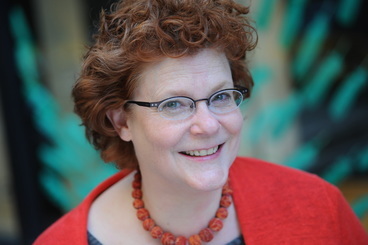 Author Pamela D. Toler Even filtered through nineteenth century gentility, the first hand accounts of Civil War hospitals are pretty grim. But many women gathered up their courage and learned not only to bandage wounds but to elbow their way through a hostile bureaucracy. They came out of the war with new skills and new confidence.
Author Pamela D. Toler Even filtered through nineteenth century gentility, the first hand accounts of Civil War hospitals are pretty grim. But many women gathered up their courage and learned not only to bandage wounds but to elbow their way through a hostile bureaucracy. They came out of the war with new skills and new confidence. And after the war many of them used their new skills at organizing and working within male-dominated bureaucracies to make the world around them a better place.
 Woman seated in doorway is volunteer nurse Abby Gibbons of New York City (Source: descendant Angela Schear, Oct. 2013. Library of Congress)
Woman seated in doorway is volunteer nurse Abby Gibbons of New York City (Source: descendant Angela Schear, Oct. 2013. Library of Congress) "Many people, including me," says Pamela, "are intrigued by the stories of the women who disguised themselves as men to fight in the Civil War. They were colorful and heroic, but their choices didn't change anything.
"I would argue that the women who served as nurses and their counterparts who ran the soldiers' aid societies that provided soldiers with basic necessities throughout the war had a profound impact on the status of women after the war. If you look at an American reform movement after 1865, the odds are you'll find a former Civil War nurse in the middle of things."
Pamela says the message she has taken from these Civil War nurses is that the first step to changing the world is challenging yourself.
Sometimes I think I get enough challenge just waking up in the morning, but these women went out and grabbed trouble by the horns and hung on. For women of their time, they were downright amazing!
What's an amazing woman for our time look like? I'd love to hear your thoughts on that.
Published on March 04, 2016 00:00
Guess Who Won the Civil War Battle between Doctors & Nurses...

Pamela D. Toler, author of a new book about the agreed to talk to me about the book, and right off, I told her I tend to be queasy.
She assured me the book touches lightly on the blood and gore of battle wounds, and focuses on the doggedness of the women nurses.
Doggedness they sorely needed because the doctors didn't want their help.
Pamela says ""Just getting to the hospital or battlefield required these women to push against societies assumptions about what ladies should and should not do.
Georgeanna Woolsey was a New York socialite who took all the trimming off one of her dresses and a bonnet, dressed her hair as plainly as possible and, to the amazement of her family, bluffed her way into a slot in the nurses training program."
 Civil War Nurses, Fredericksburg, Virginia. Library of Congress
Civil War Nurses, Fredericksburg, Virginia. Library of Congress
 Georgeanna Woolsey wrote, "No one knows who did not watch the thing from the beginning, how much opposition, how much ill-will, how much unfeeling want of thought, these women nurses endured. Hardly a surgeon whom I can think of received or treated them with even common courtesy. Government had decided that women should be employed, and the Army surgeons - unable therefore to close the hospitals against them - determined to make their lives so unbearable that they should be forced in self-defense to leave."
Georgeanna Woolsey wrote, "No one knows who did not watch the thing from the beginning, how much opposition, how much ill-will, how much unfeeling want of thought, these women nurses endured. Hardly a surgeon whom I can think of received or treated them with even common courtesy. Government had decided that women should be employed, and the Army surgeons - unable therefore to close the hospitals against them - determined to make their lives so unbearable that they should be forced in self-defense to leave."  Savage Station, Virginia. Union field hospital after the battle of June 27 Includes the straw-hatted Sixteenth New York Infantry who fought at Gaines' Mill on June 27. Most were captured when Confederates overtook the area during the battle of Savage's Station on June 29 during the Peninsular Campaign. Library of Congress Pamela says the nurses "learned to cope with the sights and smells of a military hospital—dysentery and amputations were both ugly things. Some women didn't last. And I can't blame them.
Savage Station, Virginia. Union field hospital after the battle of June 27 Includes the straw-hatted Sixteenth New York Infantry who fought at Gaines' Mill on June 27. Most were captured when Confederates overtook the area during the battle of Savage's Station on June 29 during the Peninsular Campaign. Library of Congress Pamela says the nurses "learned to cope with the sights and smells of a military hospital—dysentery and amputations were both ugly things. Some women didn't last. And I can't blame them.  Author Pamela D. Toler Even filtered through nineteenth century gentility, the first hand accounts of Civil War hospitals are pretty grim. But many women gathered up their courage and learned not only to bandage wounds but to elbow their way through a hostile bureaucracy. They came out of the war with new skills and new confidence.
Author Pamela D. Toler Even filtered through nineteenth century gentility, the first hand accounts of Civil War hospitals are pretty grim. But many women gathered up their courage and learned not only to bandage wounds but to elbow their way through a hostile bureaucracy. They came out of the war with new skills and new confidence. And after the war many of them used their new skills at organizing and working within male-dominated bureaucracies to make the world around them a better place.
 Woman seated in doorway is volunteer nurse Abby Gibbons of New York City (Source: descendant Angela Schear, Oct. 2013. Library of Congress)
Woman seated in doorway is volunteer nurse Abby Gibbons of New York City (Source: descendant Angela Schear, Oct. 2013. Library of Congress) "Many people, including me," says Pamela, "are intrigued by the stories of the women who disguised themselves as men to fight in the Civil War. They were colorful and heroic, but their choices didn't change anything.
"I would argue that the women who served as nurses and their counterparts who ran the soldiers' aid societies that provided soldiers with basic necessities throughout the war had a profound impact on the status of women after the war. If you look at an American reform movement after 1865, the odds are you'll find a former Civil War nurse in the middle of things."
Pamela says the message she has taken from these Civil War nurses is that the first step to changing the world is challenging yourself.
Sometimes I think I get enough challenge just waking up in the morning, but these women went out and grabbed trouble by the horns and hung on. For women of their time, they were downright amazing!
What's an amazing woman for our time look like? I'd love to hear your thoughts on that.
Published on March 04, 2016 00:00
February 27, 2016
5 Tips for Upping Your Curiosity Quotient and Why It Matters
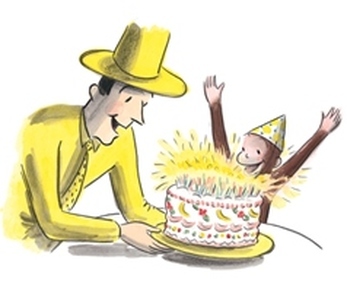 The century-old proverb, curiosity killed the cat, is usually dusted off and pronounced by an adult trying to hide something from a child.
The century-old proverb, curiosity killed the cat, is usually dusted off and pronounced by an adult trying to hide something from a child.Whether it's snicker-doodles in the cookie jar or a shameful family secret, the message is stop right there.
Story books about Curious George have been telling kids for 75-years--curiosity will get you in trouble. I'd rather see curiosity as fuel for the creative mind, a pathway to learning, a catalyst for change.
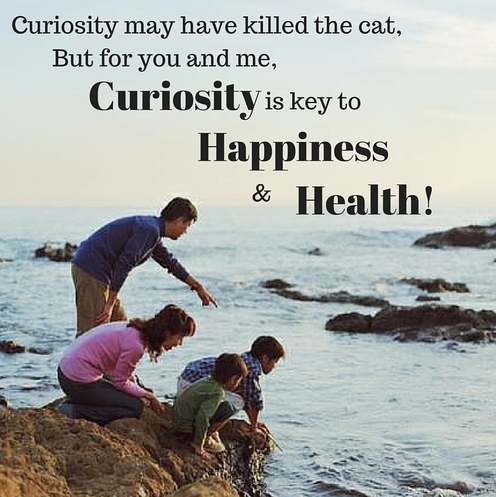 I've always had a strong a need to know, which may have led to my career as a news reporter, and more recently, writing non-fiction for kids. Although, I must admit my curiosity has gotten me into trouble a time or two.
I've always had a strong a need to know, which may have led to my career as a news reporter, and more recently, writing non-fiction for kids. Although, I must admit my curiosity has gotten me into trouble a time or two.My quest for facts can go too far. It never served me well to grill my kids for information when they came home from school. And my husband’s not too keen on me interrupting him to ask questions.
Curiosity helps improve relationships,
reduce stress
and find more
enjoyment in life
I've had to work at curbing my curiosity to become a better listener, and at the same time, redirecting my inquiries to understand myself better. A subtle probing behind my actions and reactions has turned up a wealth of information about how I tick. Sharpening my curiosity helps me improve relationships, reduce stress and find more enjoyment in life.
I came up with this list of tips from my own practice. In my experience, cultivating a gentle curiosity contributes to better mental health and happiness. 5 Tips for Better Living Through Curiosity Be curious when somebody gets under your skin. Ask yourself what your reaction reveals about you. When we blame others, we lose options, we get stuck and feel powerless. When we ask questions, we gain options and the freedom to make new choices.
Be curious about your thoughts. Many of our thoughts are not true, but we go on believing them. Moment by moment we let our thoughts say terrible things about us, things we'd never say to a friend. Pause, investigate, acknowledge some of our thoughts are ridiculous, or just plain wrong. Being curious, seeing useless, hurtful thoughts for what they are helps us begin to let them go.
Be curious about your emotions. Exploring our feelings helps us act with more clarity and wisdom. Letting emotions like fear, anger and pain go unacknowledged creates hidden motives. It sounds backward, but understanding our feelings actually helps us make more rational choices.
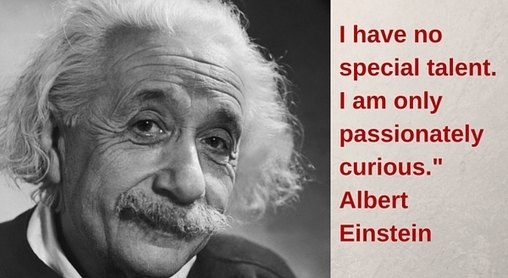 Be curious about your everyday surroundings.Rushing through the same routine day after day we can miss the excitement of being alive. Endless mystery awaits our attention, genius even. Both Isaac Newton and Albert Einstein were sitting daydreaming when everyday sights sparked amazing ideas. Newton saw an apple fall from a tree, was curious, and discovered gravity and the laws of motion. Einstein saw a builder on the rooftop, was curious what would happen if he fell, and extended his theory of relativity to gravity.
Be curious about your everyday surroundings.Rushing through the same routine day after day we can miss the excitement of being alive. Endless mystery awaits our attention, genius even. Both Isaac Newton and Albert Einstein were sitting daydreaming when everyday sights sparked amazing ideas. Newton saw an apple fall from a tree, was curious, and discovered gravity and the laws of motion. Einstein saw a builder on the rooftop, was curious what would happen if he fell, and extended his theory of relativity to gravity. Be curious about other people.There's a theory we're hardwired to hang with people like us and feel threatened by those who look different, act different or believe different. Supposedly, it goes back to the days of running around in bands protecting our food sources. But if we let go of our fear and our judgments and open our minds to discovery, relationships become more complex, more interesting, more intimate. People are fascinating if we give them a chance.
Being curious is a requirement for my work as a writer, but we're all born curious, and we can all benefit from making a conscious effort to explore, learn and discover. So please share your tips for expanding curiosity in the comment section. Thanks!
Published on February 27, 2016 09:22
Five Tips for Upping Your Curiosity Quotient and Why It Matters
 The century-old proverb, curiosity killed the cat, is usually dusted off and pronounced by an adult trying to hide something from a child.
The century-old proverb, curiosity killed the cat, is usually dusted off and pronounced by an adult trying to hide something from a child.Whether it's snicker-doodles in the cookie jar or a shameful family secret, the message is stop right there.
Story books about Curious George have been telling kids for 75-years--curiosity will get you in trouble. I'd rather see curiosity as fuel for the creative mind, a pathway to learning, a catalyst for change.
 I've always had a strong a need to know, which may have led to my career as a news reporter, and more recently, writing non-fiction for kids. Although, I must admit my curiosity has gotten me into trouble a time or two.
I've always had a strong a need to know, which may have led to my career as a news reporter, and more recently, writing non-fiction for kids. Although, I must admit my curiosity has gotten me into trouble a time or two.My quest for facts can go too far. It never served me well to grill my kids for information when they came home from school. And my husband’s not too keen on me interrupting him to ask questions.
Curiosity helps improve relationships,
reduce stress
and you find more
enjoyment in life
I've had to work at curbing my curiosity to become a better listener, and at the same time, redirecting my inquiries to understand more about myself. A subtle probing behind my actions and reactions has turned up a wealth of information about how I tick. Sharpening my curiosity helps me improve relationships, reduce stress and find more enjoyment in life.
I came up with this list of tips from my own practice. In my experience, cultivating a gentle curiosity contributes to better mental health and happiness. 5 Tips for Better Living Through Curiosity Be curious when somebody gets under your skin. Ask yourself what your reaction reveals about you. When we blame others, we lose options, we get stuck and feel powerless. When we ask questions, we gain options and the freedom to make new choices.
Be curious about your thoughts. Many of our thoughts are not true, but we go on believing them. Moment by moment we let our thoughts say terrible things about us, things we'd never say to a friend. Pause, investigate, acknowledge some of our thoughts are ridiculous, or just plain wrong. Being curious, seeing useless, hurtful thoughts for what they are helps us begin to let them go.
Be curious about your emotions. Exploring our feelings helps us act with more clarity and wisdom. Letting emotions like fear, anger and pain go unacknowledged creates hidden motives. It sounds backward, but understanding our feelings, actually helps us make more rational choices.
 Be curious about your everyday surroundings.Rushing through the same routine day after day we can miss the excitement of being alive. Endless mystery awaits our attention, genius even. Both Isaac Newton and Albert Einstein were sitting daydreaming when everyday sights sparked amazing ideas. Newton saw an apple fall from a tree, was curious, and discovered gravity and the laws of motion. Einstein saw a builder on the rooftop was curious what would happen if he fell, and extended his theory of relativity to gravity.
Be curious about your everyday surroundings.Rushing through the same routine day after day we can miss the excitement of being alive. Endless mystery awaits our attention, genius even. Both Isaac Newton and Albert Einstein were sitting daydreaming when everyday sights sparked amazing ideas. Newton saw an apple fall from a tree, was curious, and discovered gravity and the laws of motion. Einstein saw a builder on the rooftop was curious what would happen if he fell, and extended his theory of relativity to gravity. Be curious about other people.There's a theory we're hardwired to hang with people like us and feel threatened by those who look different, act different or believe different. Supposedly it goes back to the days of running around in bands protecting our food sources. But if we let go of our fear and our judgments open our minds to discovery, relationships become more complex, more interesting, more intimate. People are fascinating if we give them a chance.
Being curious is a requirement for my work as a writer, but we're all born curious, and we can all benefit from making a conscious effort to explore, learn and discover. So please share your tips for expanding curiosity in the comment section. Thanks!
Published on February 27, 2016 09:22
February 17, 2016
You Won't Want to Miss this Vivid, Inspiring Native American Story
Once in a while you find a book that you want to buy for everyone you know.
Hiawatha and the Peacemaker strikes me that way. I thought it ironic that I stumbled upon this book in the middle of great debate about immigration in America, about how best to confront terrorism and about how to be most true to our democratic ideals.
I thought it ironic that I stumbled upon this book in the middle of great debate about immigration in America, about how best to confront terrorism and about how to be most true to our democratic ideals.
Hiawatha lived in a time of war, when violence could strike without warning and without mercy. His people, the Iroquois ranged across what is now New York State, Ontario and Quebec long before European immigrants arrived.
The story opens with Hiawatha mourning his wife and three daughters. They'd been killed in an attack on his village and everything he cared about had been burned to the ground. Vivid illustrations by David Shannon evoke emotion throughout the story. Hiawatha could think of nothing but revenge, until a stranger showed up and told him of the Great Law of Peace.
“Fighting among our people must stop. We must come together as one body, one mind, and one heart.”
Hiawatha could think of nothing but revenge, until a stranger showed up and told him of the Great Law of Peace.
“Fighting among our people must stop. We must come together as one body, one mind, and one heart.”
Hiawatha was skeptical, but agreed to go to his people, the Mohawk, and help the Peacemaker present the Great Law. The Clan Mothers nodded at this idea of becoming one family, but the War Chief argued that the Onondaga chief was too strong, too violent and the Mohawk must remain ready to fight.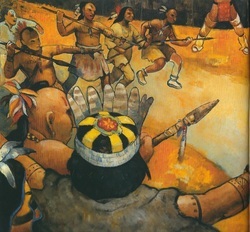 Hiawatha and the Peacemaker left the Mohawk, traveling to carry the message to the Cayuga, the Oneida, the Seneca and the Onondaga. He faced down hostile warriors, suspicion, and his own hatred, anger and pain.
Hiawatha and the Peacemaker left the Mohawk, traveling to carry the message to the Cayuga, the Oneida, the Seneca and the Onondaga. He faced down hostile warriors, suspicion, and his own hatred, anger and pain.
With the help of the Peacemaker Hiawatha was healed of his desire for revenge and learned forgiveness.
Eventually, they succeeded in bringing the five nations together to lay down their weapons and trust peace.
The Five Nations of the Iroquois formed a confederacy on the Great Law of Peace, thought to be the oldest participatory democracy on earth. Benjamin Franklin, John Hancock and Thomas Jefferson were influenced by this peaceful union's self-government.
The author of the book, Robbie Robertson wrote the story from his memory of hearing it as a child from an Elder wisdom-keeper on the reservation. Robertson is of Mohawk and Cayuga heritage.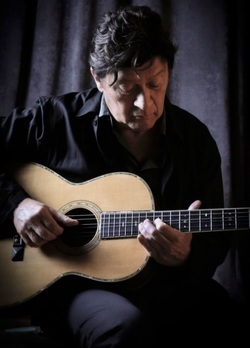 According to Robertson, Henry Wadsworth Longfellow mixed up another man with the real Hiawatha in his poem, so don't look for Gutche Gumee in this book.
According to Robertson, Henry Wadsworth Longfellow mixed up another man with the real Hiawatha in his poem, so don't look for Gutche Gumee in this book.
This book is not his first foray into the arts. Robinson has a long and distinguished career in music for which he's been inducted into the Rock & Roll Hall of Fame, given a Grammy Lifetime Achievement Award, landed on Rolling Stone magazine’s lists of greatest artists and greatest guitar players of all time, as well as collaborated with filmmaker Martin Scorsese, and produced albums by artists like Van Morrison and Neil Diamond.
I can't leave this story without mentioning that in the Iroquois Federation men and women shared power. A Clan Mother Jikonhsaseh was
instrumental in forming the democracy.
Hiawatha and the Peacemaker strikes me that way.
 I thought it ironic that I stumbled upon this book in the middle of great debate about immigration in America, about how best to confront terrorism and about how to be most true to our democratic ideals.
I thought it ironic that I stumbled upon this book in the middle of great debate about immigration in America, about how best to confront terrorism and about how to be most true to our democratic ideals.Hiawatha lived in a time of war, when violence could strike without warning and without mercy. His people, the Iroquois ranged across what is now New York State, Ontario and Quebec long before European immigrants arrived.
The story opens with Hiawatha mourning his wife and three daughters. They'd been killed in an attack on his village and everything he cared about had been burned to the ground. Vivid illustrations by David Shannon evoke emotion throughout the story.
 Hiawatha could think of nothing but revenge, until a stranger showed up and told him of the Great Law of Peace.
“Fighting among our people must stop. We must come together as one body, one mind, and one heart.”
Hiawatha could think of nothing but revenge, until a stranger showed up and told him of the Great Law of Peace.
“Fighting among our people must stop. We must come together as one body, one mind, and one heart.”
Hiawatha was skeptical, but agreed to go to his people, the Mohawk, and help the Peacemaker present the Great Law. The Clan Mothers nodded at this idea of becoming one family, but the War Chief argued that the Onondaga chief was too strong, too violent and the Mohawk must remain ready to fight.
 Hiawatha and the Peacemaker left the Mohawk, traveling to carry the message to the Cayuga, the Oneida, the Seneca and the Onondaga. He faced down hostile warriors, suspicion, and his own hatred, anger and pain.
Hiawatha and the Peacemaker left the Mohawk, traveling to carry the message to the Cayuga, the Oneida, the Seneca and the Onondaga. He faced down hostile warriors, suspicion, and his own hatred, anger and pain.
With the help of the Peacemaker Hiawatha was healed of his desire for revenge and learned forgiveness.
Eventually, they succeeded in bringing the five nations together to lay down their weapons and trust peace.
The Five Nations of the Iroquois formed a confederacy on the Great Law of Peace, thought to be the oldest participatory democracy on earth. Benjamin Franklin, John Hancock and Thomas Jefferson were influenced by this peaceful union's self-government.
The author of the book, Robbie Robertson wrote the story from his memory of hearing it as a child from an Elder wisdom-keeper on the reservation. Robertson is of Mohawk and Cayuga heritage.
 According to Robertson, Henry Wadsworth Longfellow mixed up another man with the real Hiawatha in his poem, so don't look for Gutche Gumee in this book.
According to Robertson, Henry Wadsworth Longfellow mixed up another man with the real Hiawatha in his poem, so don't look for Gutche Gumee in this book. This book is not his first foray into the arts. Robinson has a long and distinguished career in music for which he's been inducted into the Rock & Roll Hall of Fame, given a Grammy Lifetime Achievement Award, landed on Rolling Stone magazine’s lists of greatest artists and greatest guitar players of all time, as well as collaborated with filmmaker Martin Scorsese, and produced albums by artists like Van Morrison and Neil Diamond.
I can't leave this story without mentioning that in the Iroquois Federation men and women shared power. A Clan Mother Jikonhsaseh was
instrumental in forming the democracy.
Published on February 17, 2016 08:25
February 6, 2016
Completely helpless at the whim of people who want to kill you...
 Thanks to
Author Brandon Marie Miller
for guest posting here this week, filling in while I recover from my six-day research trip to Washington D.C.
Thanks to
Author Brandon Marie Miller
for guest posting here this week, filling in while I recover from my six-day research trip to Washington D.C.Brandon is an award-winning author of nine titles on U.S. history topics. Her story about a woman accused of witchcraft and hanged, touches on an experience I've been thinking a lot about lately.
Being completely helpless at the whim of people who want to kill you.
My research turned up a letter to President Roosevelt from a woman whose son is set to be hanged by the U.S. Army. Just thinking of this kind of helplessness makes me short of breath.
 You've probably heard the name of Eddie Slovak, the white soldier executed for deserting in WWII. They even made a movie about him. Seen any movies about a black soldier executed?
You've probably heard the name of Eddie Slovak, the white soldier executed for deserting in WWII. They even made a movie about him. Seen any movies about a black soldier executed?Out of 70 soldiers court-martialed and executed in Europe during the war years, 55 of the men were black. Blacks made of 10 percent of the army.
A number of these men were hanged on extremely flimsy testamony. There's some evidence black soldiers were scapegoated for the crime of rape to save the reputation of the US Army during WWII.
In her new book, Women of Colonial America, Brandon Marie Miller writes about a woman facing similar circumstances. The Courage of Martha Corey
 Martha Corey on trial She says, "to be accused of a crime-- with your life hanging in the balance-- and have no way to defend yourself, is terrifying. "
Martha Corey on trial She says, "to be accused of a crime-- with your life hanging in the balance-- and have no way to defend yourself, is terrifying. " Brandon knew the ending to Martha Corey's story before she started her research. Martha's name appears on the list of those executed for practicing witchcraft in Salem Village in 1692.
Brandon's challenge was to make Martha more than just a name and get readers to care about her. So, how'd you answer that challenge, Brandon?
 The answer lay in the 300-year-old record of Martha's examination and court depositions.
The answer lay in the 300-year-old record of Martha's examination and court depositions.
She at first briskly denied the accusations. But as the "afflicted" girls took over the courtroom with their hysterics, I felt her shift to bewilderment, to panic, to despair.
My heart ached for Martha, so alone against so many. I felt anger toward the accusers. Only one of the girls later publicly apologized for her role, saying she'd been deluded by the devil.
Martha remained true to herself through months of imprisonment. She never attempted to save herself by confessing or accusing others. And in the face of mass hysteria, that took real courage.
Three women had already been accused of witchcraft when a constable arrived at the home of Giles and Martha Corey in March 1692. The man carried a warrant for Martha’s arrest, charging she’d “committed sundry acts of Witchcraft.” Martha's arrest warrent
"...suspicion of having committed sundry acts of witchcraft and thereby done much harm..."
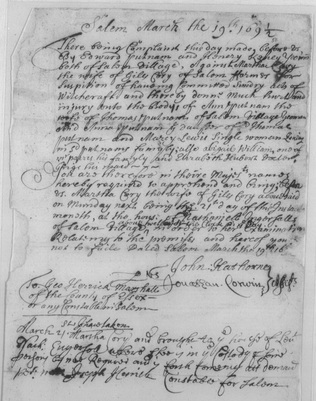 Since January, witch hysteria had swept Salem Village. A handful of preteen girls and teenage servants made the accusations. Normally, society would scarcely notice these girls.
Since January, witch hysteria had swept Salem Village. A handful of preteen girls and teenage servants made the accusations. Normally, society would scarcely notice these girls.Now, people recorded their every sentence, every move. Older and poorer women proved easy targets. Martha’s arrest shocked people; she was a prosperous farmer’s wife and an elected church member.
Twelve-year-old Ann Putnam had first told her parents that Martha appeared to her and tortured her with pinching “and other ways.” When Martha visited the Putnam house Ann fell into a choking fit, her body twisted in agony.
 A servant in the household claimed Martha’s apparition beat her with an iron rod. Other girlish voices chimed in over the next few weeks-- Martha hurt them and consorted with the devil.
A servant in the household claimed Martha’s apparition beat her with an iron rod. Other girlish voices chimed in over the next few weeks-- Martha hurt them and consorted with the devil.Two days after her arrest Martha appeared before Magistrate John Hathorne in Salem’s packed meeting house. Hathorne’s first words accused her: “You are now in the hands of Authority tell me now why you hurt these persons.”
Martha denied she hurt anyone. “I am an innocent person : I never had to do with Witchcraft since I was born,” she answered. “I am a Gospel Woman.”
Hathorne soon lost control of the court when “the afflicted” interrupted the proceedings. Abigail Williams pointed toward Martha—“There is a man whispering in her ear.”
“We must not believe all that these distracted children say,” Martha told Hathorne. “I saw no body.”
Then the accusers fell to the floor, shrieking in pain. Martha must have looked on, helpless and horrified. The judge urged her to confess, adding, “Do you think to find mercy by aggravating your sins?”
Martha simply replied, “But I cannot confess.” Martha continued to proclaim her innocence. “What can I do? Many rise up against me.”
Nineteen people were hanged after being convicted in the Salem Witch Trials.
Thank you, Brandon! I'm looking forward to reading your new book!
When I visited the Salem Witch Trial Museum several years ago, they had a wonderful exhibit showing how the accusations of witchcraft fit into a pattern of scapegoating and violence down through the centuries.
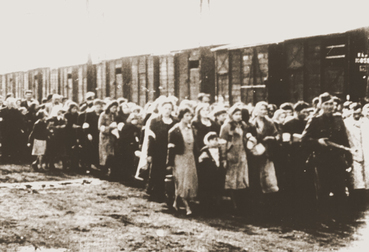 Warsaw Ghetto Deportations - Photo courtesy http://holocaustresearchproject.org Of course, a prime example is the the Holocaust, which just so happens to be another topic I've been researching lately.
Warsaw Ghetto Deportations - Photo courtesy http://holocaustresearchproject.org Of course, a prime example is the the Holocaust, which just so happens to be another topic I've been researching lately. I can't help feeling great gratitude that I get to sleep at night without worrying I'll be targeted by violence. And I can't help thinking about other groups of people here in America and around the world that don't have that luxury.
Read about Martha and 13 more courageous Colonial Women here.
Check out Brandon's website here...
Published on February 06, 2016 19:44
January 22, 2016
Meet this Japanese Hero of the Holocaust
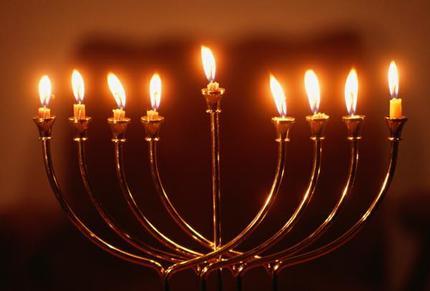 It's 1939 Lithuania.
It's 1939 Lithuania.A young boy wants to see the latest Laurel and Hardy movie, but he's given away his allowance to help Jewish refugees, thousands of them flooding in from Poland hoping to escape the Nazis.
Solly decides to hit up his aunt for a loan, one Lithuanian coin for the movie. At his aunt's shop a stranger overhears Solly's request and spontaneously offers the boy two coins. On impulse, the boy invites the stranger to his family's first night of Chanukah celebration.
That's how the Japanese Consul to Lithuania Chiune Sugihara came to attend Jewish Chanukah.
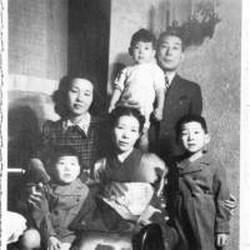 Sugihara noticed the affection between Solly's relatives and it reminded him of his own family, and of similar Japanese festivals. A friendship grew between the Japanese man and the Russian Jewish boy and his father.
Sugihara noticed the affection between Solly's relatives and it reminded him of his own family, and of similar Japanese festivals. A friendship grew between the Japanese man and the Russian Jewish boy and his father.The following summer, Sugihara and his wife and children, woke one morning in mid-July to an enormous clamor outside. Peering out the window, they saw scores of people crowded up against the consulate fence. They were Jewish refugees desperate to flee the Nazis.

Most countriesIn little time, one hundred people grew to two hundred, and within days, thousands lined up in fear for their lives, believing their only path to freedom might be a Japanese transit visa, the ticket to a Soviet exit visa. They had few options. Most of the free world refused to take in Jewish refugees from Poland or anywhere in Nazi-occupied Europe.
refused
to take
Jewish refugees trying to escape
the Nazis.
Three times Chiune Sugihara wired Tokyo for permission to issue the Jewish refugees visas. Three times he was denied. He discussed the situation with his wife and children. "I spent an entire night plunged in thought," he wrote later.
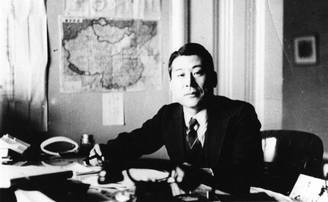
A career diplomat, bound by the traditional obedience of the Japanese culture, Sugihara knew he risked disgrace, and he feared for the safety of his wife and children.
"I spent
an entire night plunged in thought."
"I could have refused to issue them, but would that, in the end, have truly been in Japan’s national interest? I came to the conclusion, after racking my brain, that the spirit of humane and charitable action takes precedence above all else," he wrote in is 1984 memoir. "“I am convinced to this day that I took that path of action faithfully, putting my job on the line, without fear or trepidation in my heart.”
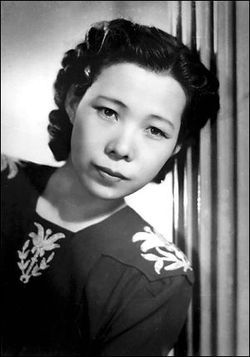 Sugihara and his wife Yukiko sat down and began to write visas.
Sugihara and his wife Yukiko sat down and began to write visas.For 29 days, from July 31 to August 28, 1940, they wrote and signed visas by hand, more than 300 a day. Yukiko made him sandwiches, when Sugihara refused to stop for meals. Jewish refugees lined outside waiting and when some climb over the consulate fence, Sugihara paused to go out and promise he was doing all he could to help them.
"They were human beings and they needed help," he said later. "I'm glad I found the strength to make the decision to give it to them."
Sugihara was a religious man and believed in a universal God of all people. He was fond of saying, "I may have to disobey my government, but if I don't I would be disobeying God."
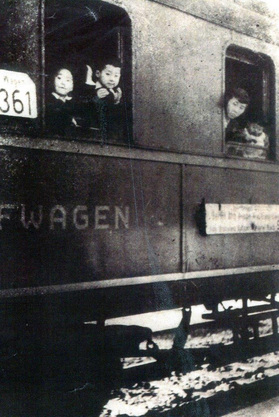 At the end of August, Sugihara was sent to a new post. As his family boarded the train to Berlin, he continued issuing documents through the window, and as the train left the station, handed his consul visa stamp to a refugee to authenticate more visas.
At the end of August, Sugihara was sent to a new post. As his family boarded the train to Berlin, he continued issuing documents through the window, and as the train left the station, handed his consul visa stamp to a refugee to authenticate more visas. Sugihara is credited with saving some 6000 Jews from the Nazis.
As for Sugihara's young friend...most of Solly's family was murdered in the Holocaust. But Solly and his father survived in one of the outer camps of Dachau. Ironically, in May 1945, Solly was liberated by Japanese American soldiers of the 522nd Field Artillery Battalion, men who had been interned in their own country.
Thanks to the Japan Times and the Jewish Virtual Library for photos and information.
Published on January 22, 2016 00:00
November 3, 2015
A Brave, Romantic.... & Tragic Affair
In the midst of photo research for PURE GRIT, I discovered the love story of Annalee Whitmore and Melville Jacoby. Right off, I admired Annalee's daring. And I was curious how she ended up in taking photographs of Army nurses serving in the Battle of Bataan.
She got credit for this photo in LIFE magazine. Her daughter told me credit for the rest of her photos went to her husband, Melville Jacoby, officially the reporter for Time and LIFE. Photo courtesy Susan Johnson, her mother Army Nurse Jeanne Kennedy is pictured at the lower left.
Photo courtesy Susan Johnson, her mother Army Nurse Jeanne Kennedy is pictured at the lower left.  In 1940, the expected role for US women in their twenties was to get married and start a family. Not Whitmore. She had several hit Hollywood screenplays to her credit and a 7-year contract with MGM.
In 1940, the expected role for US women in their twenties was to get married and start a family. Not Whitmore. She had several hit Hollywood screenplays to her credit and a 7-year contract with MGM.
But war had broken out in China, and fascism was on the march. Annalee had edited the student newspaper at Stanford and like any good journalist, she wanted to see action.
Annalee rustled up an assignment in China with Reader's Digest, but the American government would not allow women reporters in the war zone. She heard a fellow-Stanford graduate who'd been to China was in town and she got in touch. Mel Jacoby agreed to meet her for a drink at a bar on Wilshire Boulevard and she picked his brain. Yes, he would help, and through his connections Annalee got a position with United China Relief in Chungking.
Mel Jacoby agreed to meet her for a drink at a bar on Wilshire Boulevard and she picked his brain. Yes, he would help, and through his connections Annalee got a position with United China Relief in Chungking.
Already smitten, Annalee was happy to find Mel was going back to China, where he became a correspondent for Time, and the two started having dinner together every evening.
As Japan grew more threatening in the fall of 1941, most Americans left China. Mel was assigned to report on events in Manila and pleaded with Annalee to come along and marry him. In November, she did, arriving on the 26th. The couple went straight to the church.
They had only just returned to Manila from their honeymoon when the Japanese bombed Pearl Harbor, and within hours, attacked the Philippines.
It was too late to leave the islands. Due to Mel's reporting in China, he was on a Japanese blacklist, and would be executed if caught.
The couple decided to retreat with the U.S. Army to Bataan and Corregidor, try to hold out for reinforcements.
As the battle surged through January and February, Annalee covered it for Liberty magazine, though most of her stories did not pass the military censors. She talked to men who'd been on the front line for weeks. "All night they hope for daylight because of the snipers, all day they hope for night so the waves of enemy planes will stop." She talked to nurses soldiering on as medical supplies and food dwindled. She wrote they all hoped to hold until until help came.
Soon it was clear no help would come. The reporters discussed the chances of getting out, getting their stories out, possibly influencing the War Department. Chances of survival here, looked grim.
 Major General Edward King discusses terms of surrender with Japanese officers. The surrender at Bataan was the largest in American and Filipino military histories. Mel made arrangements for himself and Annalee on a boat. They boarded at night and navigated through the minefields to open water. Traveling by dark, sheltering along the coast when the sun came up, eventually the arrived at Cebu Island where they waited for a second larger boat.
Major General Edward King discusses terms of surrender with Japanese officers. The surrender at Bataan was the largest in American and Filipino military histories. Mel made arrangements for himself and Annalee on a boat. They boarded at night and navigated through the minefields to open water. Traveling by dark, sheltering along the coast when the sun came up, eventually the arrived at Cebu Island where they waited for a second larger boat.
After waiting and watching four days, they caught the Dona Nati and set off for Australia, evading Japanese warships. "There was always a tight feeling in our stomachs," Annalee said. It was twenty-two days before they sighted Brisbane. Here's where I wanted to believe Mel and Annalee lived happily ever after. Working together taking pictures and writing stories.
Here's where I wanted to believe Mel and Annalee lived happily ever after. Working together taking pictures and writing stories.
But two months after the couple arrived in Australia, Mel stood on a secret Australian airfield waiting to board a plane with a small group of military men. A fighter plane lost control on take off and careened into the group. Jacoby was killed instantly. He was 25, the first American correspondent to die in a WWII combat theater.
Annalee was heartbroken. After the war she returned to China, still one of very few women journalists there. She's most well-known for the book she co-authored with Theodore H. White called Thunder out of China.
She got credit for this photo in LIFE magazine. Her daughter told me credit for the rest of her photos went to her husband, Melville Jacoby, officially the reporter for Time and LIFE.
 Photo courtesy Susan Johnson, her mother Army Nurse Jeanne Kennedy is pictured at the lower left.
Photo courtesy Susan Johnson, her mother Army Nurse Jeanne Kennedy is pictured at the lower left.  In 1940, the expected role for US women in their twenties was to get married and start a family. Not Whitmore. She had several hit Hollywood screenplays to her credit and a 7-year contract with MGM.
In 1940, the expected role for US women in their twenties was to get married and start a family. Not Whitmore. She had several hit Hollywood screenplays to her credit and a 7-year contract with MGM.But war had broken out in China, and fascism was on the march. Annalee had edited the student newspaper at Stanford and like any good journalist, she wanted to see action.
Annalee rustled up an assignment in China with Reader's Digest, but the American government would not allow women reporters in the war zone. She heard a fellow-Stanford graduate who'd been to China was in town and she got in touch.
 Mel Jacoby agreed to meet her for a drink at a bar on Wilshire Boulevard and she picked his brain. Yes, he would help, and through his connections Annalee got a position with United China Relief in Chungking.
Mel Jacoby agreed to meet her for a drink at a bar on Wilshire Boulevard and she picked his brain. Yes, he would help, and through his connections Annalee got a position with United China Relief in Chungking.Already smitten, Annalee was happy to find Mel was going back to China, where he became a correspondent for Time, and the two started having dinner together every evening.
As Japan grew more threatening in the fall of 1941, most Americans left China. Mel was assigned to report on events in Manila and pleaded with Annalee to come along and marry him. In November, she did, arriving on the 26th. The couple went straight to the church.

They had only just returned to Manila from their honeymoon when the Japanese bombed Pearl Harbor, and within hours, attacked the Philippines.
It was too late to leave the islands. Due to Mel's reporting in China, he was on a Japanese blacklist, and would be executed if caught.
The couple decided to retreat with the U.S. Army to Bataan and Corregidor, try to hold out for reinforcements.
As the battle surged through January and February, Annalee covered it for Liberty magazine, though most of her stories did not pass the military censors. She talked to men who'd been on the front line for weeks. "All night they hope for daylight because of the snipers, all day they hope for night so the waves of enemy planes will stop." She talked to nurses soldiering on as medical supplies and food dwindled. She wrote they all hoped to hold until until help came.
Soon it was clear no help would come. The reporters discussed the chances of getting out, getting their stories out, possibly influencing the War Department. Chances of survival here, looked grim.
 Major General Edward King discusses terms of surrender with Japanese officers. The surrender at Bataan was the largest in American and Filipino military histories. Mel made arrangements for himself and Annalee on a boat. They boarded at night and navigated through the minefields to open water. Traveling by dark, sheltering along the coast when the sun came up, eventually the arrived at Cebu Island where they waited for a second larger boat.
Major General Edward King discusses terms of surrender with Japanese officers. The surrender at Bataan was the largest in American and Filipino military histories. Mel made arrangements for himself and Annalee on a boat. They boarded at night and navigated through the minefields to open water. Traveling by dark, sheltering along the coast when the sun came up, eventually the arrived at Cebu Island where they waited for a second larger boat.After waiting and watching four days, they caught the Dona Nati and set off for Australia, evading Japanese warships. "There was always a tight feeling in our stomachs," Annalee said. It was twenty-two days before they sighted Brisbane.
 Here's where I wanted to believe Mel and Annalee lived happily ever after. Working together taking pictures and writing stories.
Here's where I wanted to believe Mel and Annalee lived happily ever after. Working together taking pictures and writing stories.But two months after the couple arrived in Australia, Mel stood on a secret Australian airfield waiting to board a plane with a small group of military men. A fighter plane lost control on take off and careened into the group. Jacoby was killed instantly. He was 25, the first American correspondent to die in a WWII combat theater.
Annalee was heartbroken. After the war she returned to China, still one of very few women journalists there. She's most well-known for the book she co-authored with Theodore H. White called Thunder out of China.
Published on November 03, 2015 16:22
October 16, 2015
Eviscerating and Freeing at the Same Time
When tragedy or loss shatters our heart, we have moments when it's difficult, even impossible, to imagine putting all the pieces back together. They don't teach that in school.
So when I meet someone who's done it, someone who has made their way through sorrow and pain to find joy and fullness of life, I want to know how they did it.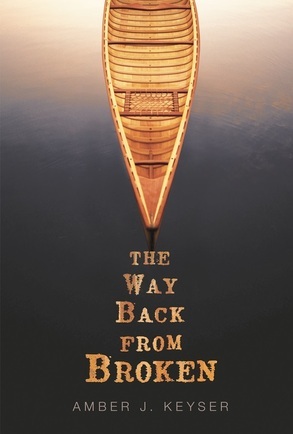 Amber J. Keyser’s debut novel THE WAY BACK FROM BROKEN tells the story of a fifteen-year-old boy and a ten-year-old girl thrown together by tragedy who find hope and healing in the Canadian wilderness.
Amber J. Keyser’s debut novel THE WAY BACK FROM BROKEN tells the story of a fifteen-year-old boy and a ten-year-old girl thrown together by tragedy who find hope and healing in the Canadian wilderness.
There is an intensely personal story behind this book, and I'm honored and grateful the author has agreed to post today and share her story. Amber...
I have always used writing to sort through my experiences, my deepest thoughts, and my hidden fears. There is a box of journals in my attic begun in high school and continued sporadically for all these years into which I penciled my troubles and my victories. For me, words were a way to both exorcise the demons that haunted me and to make sense of my life and relationships.
When I was expecting my first child, a little girl named Esther Rose, my journal entries turned into letters. I chronicled her first movements, my dreams of her, and my hopes for our life together. I wrote to a person that I knew more intimately than anyone else in the world. I wrote from a deep sense that she was the child I had been waiting for my whole life. Together we were forging a new future.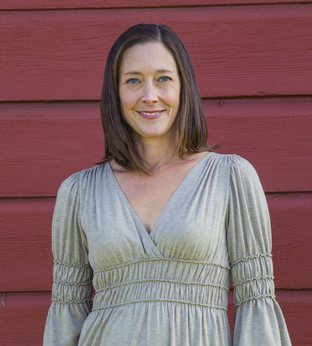 Author Amber J. Keyser And then she died, this baby girl of mine. This heart of my heart. A cord accident during labor ended her life before it even had a chance to begin. For a long time I thought it had ended mine as well. But I kept writing letters to my daughter. I poured my grief onto the page.
Author Amber J. Keyser And then she died, this baby girl of mine. This heart of my heart. A cord accident during labor ended her life before it even had a chance to begin. For a long time I thought it had ended mine as well. But I kept writing letters to my daughter. I poured my grief onto the page.
This was fifteen years ago, and the words I wrote were nowhere close to a novel. It took ten years walking the paths of grief, and the safe births of two more children, before I felt ready to write about my loss for others to read.
When I began, one of the women in my critique group asked me if I was ready, really ready, to go back into the shadows. She reminded me of how long it would take, how many times I would have to revise, and how it might feel to receive feedback on such personal material. And yet I forged ahead, crafting characters, who were partly me but also not me, to carry a story that was partly mine but also not mine.
Later on, when I was bringing pages to our group, another member had to gently, so gently, remind me not to let the mother take over the story. This was indeed the challenge of writing THE WAY BACK FROM BROKEN. A challenge I faced again and again and again.
To write a novel that would be both honest and true, I had to return to very painful places, but I also had to find a way to peel the emotional truth from my experience and transfer it into the story. It is hard to describe how this worked, harder still to explain how it felt.
The words that capture it best are from THE VOYAGE OF THE DAWN TREADER by CS Lewis. When Eustace describes how Aslan changed him from a dragon back into a boy, he says: #element-c62a13c3-3d26-453e-bd49-5d39d311b6b1 .callout-box--standard { border: 4px solid #8d2424; background: #a1a1a1; padding: 40px; margin: 20px 0;}#element-c62a13c3-3d26-453e-bd49-5d39d311b6b1 .callout-box--material { border: 4px solid #8d2424; background: #a1a1a1; padding: 40px; margin: 20px 0; box-shadow: 0 0 20px rgba(0,0,0,0.15);}#element-c62a13c3-3d26-453e-bd49-5d39d311b6b1 .callout-base { border: 4px solid #8d2424; background: #a1a1a1; padding: 40px; margin: 20px 0;}#element-c62a13c3-3d26-453e-bd49-5d39d311b6b1 .material { box-shadow: 0 0 20px rgba(0,0,0,0.15);} The very first tear he made was so deep that I thought it had gone right into my heart. And when he began pulling the skin off, it hurt worse than anything I’ve ever felt. The only thing that made me able to bear it was just the pleasure of feeling the stuff peel off. You know—if you’ve ever picked the scab off a sore place. It hurts like billy-oh but it is such fun to see it coming away.~ C.S. Lewis
Over time, my letter writing to my baby has diminished until for the past ten years or so I have only written her letters on her birthday. This year was the first one in which I didn’t even do that. I didn’t forget. I just didn’t need to. THE WAY BACK FROM BROKEN is my love song to the daughter I didn’t get to raise, and it says exactly what I needed it to say.
And here's what Booklist is saying in its starred review, “Keyser’s debut novel is an exquisite and enthralling exploration of loss, love, and healing.”
Thanks so much for sharing, Amber.
For more about Amber J. Keyser, her books and her upcoming appearances check out her website here: www.amberjkeyser.com.
More about THE WAY BACK FROM BROKEN:
Rakmen Cannon’s life is turning out to be one sucker punch after another. His baby sister died in his arms, his parents are on the verge of divorce, and he’s flunking out of high school. The only place he fits in is with the other art therapy kids stuck in the basement of Promise House, otherwise known as support group central. Not that he wants to be there. Talking doesn’t bring back the dead.
When he’s shipped off to the Canadian wilderness with ten-year-old Jacey, another member of the support group, and her mom, his summer goes from bad to worse. He can’t imagine how eight weeks of canoeing and camping could be anything but awful.
Yet despite his expectations, the vast and unforgiving backcountry just might give Rakmen a chance to find the way back from broken . . . if he’s brave enough to grab it.
To buy the book click here...
So when I meet someone who's done it, someone who has made their way through sorrow and pain to find joy and fullness of life, I want to know how they did it.
 Amber J. Keyser’s debut novel THE WAY BACK FROM BROKEN tells the story of a fifteen-year-old boy and a ten-year-old girl thrown together by tragedy who find hope and healing in the Canadian wilderness.
Amber J. Keyser’s debut novel THE WAY BACK FROM BROKEN tells the story of a fifteen-year-old boy and a ten-year-old girl thrown together by tragedy who find hope and healing in the Canadian wilderness. There is an intensely personal story behind this book, and I'm honored and grateful the author has agreed to post today and share her story. Amber...
I have always used writing to sort through my experiences, my deepest thoughts, and my hidden fears. There is a box of journals in my attic begun in high school and continued sporadically for all these years into which I penciled my troubles and my victories. For me, words were a way to both exorcise the demons that haunted me and to make sense of my life and relationships.
When I was expecting my first child, a little girl named Esther Rose, my journal entries turned into letters. I chronicled her first movements, my dreams of her, and my hopes for our life together. I wrote to a person that I knew more intimately than anyone else in the world. I wrote from a deep sense that she was the child I had been waiting for my whole life. Together we were forging a new future.
 Author Amber J. Keyser And then she died, this baby girl of mine. This heart of my heart. A cord accident during labor ended her life before it even had a chance to begin. For a long time I thought it had ended mine as well. But I kept writing letters to my daughter. I poured my grief onto the page.
Author Amber J. Keyser And then she died, this baby girl of mine. This heart of my heart. A cord accident during labor ended her life before it even had a chance to begin. For a long time I thought it had ended mine as well. But I kept writing letters to my daughter. I poured my grief onto the page.This was fifteen years ago, and the words I wrote were nowhere close to a novel. It took ten years walking the paths of grief, and the safe births of two more children, before I felt ready to write about my loss for others to read.
When I began, one of the women in my critique group asked me if I was ready, really ready, to go back into the shadows. She reminded me of how long it would take, how many times I would have to revise, and how it might feel to receive feedback on such personal material. And yet I forged ahead, crafting characters, who were partly me but also not me, to carry a story that was partly mine but also not mine.
"I had to return
to very painful places"
Later on, when I was bringing pages to our group, another member had to gently, so gently, remind me not to let the mother take over the story. This was indeed the challenge of writing THE WAY BACK FROM BROKEN. A challenge I faced again and again and again.
To write a novel that would be both honest and true, I had to return to very painful places, but I also had to find a way to peel the emotional truth from my experience and transfer it into the story. It is hard to describe how this worked, harder still to explain how it felt.
The words that capture it best are from THE VOYAGE OF THE DAWN TREADER by CS Lewis. When Eustace describes how Aslan changed him from a dragon back into a boy, he says: #element-c62a13c3-3d26-453e-bd49-5d39d311b6b1 .callout-box--standard { border: 4px solid #8d2424; background: #a1a1a1; padding: 40px; margin: 20px 0;}#element-c62a13c3-3d26-453e-bd49-5d39d311b6b1 .callout-box--material { border: 4px solid #8d2424; background: #a1a1a1; padding: 40px; margin: 20px 0; box-shadow: 0 0 20px rgba(0,0,0,0.15);}#element-c62a13c3-3d26-453e-bd49-5d39d311b6b1 .callout-base { border: 4px solid #8d2424; background: #a1a1a1; padding: 40px; margin: 20px 0;}#element-c62a13c3-3d26-453e-bd49-5d39d311b6b1 .material { box-shadow: 0 0 20px rgba(0,0,0,0.15);} The very first tear he made was so deep that I thought it had gone right into my heart. And when he began pulling the skin off, it hurt worse than anything I’ve ever felt. The only thing that made me able to bear it was just the pleasure of feeling the stuff peel off. You know—if you’ve ever picked the scab off a sore place. It hurts like billy-oh but it is such fun to see it coming away.~ C.S. Lewis
"evisceratingIt was like that for me—eviscerating and freeing at the same time. There were many times that I wept, and afterwards I would experience a strange lightness as if transferring suffering to the page had unburdened me. To my surprise, this sensation of having released my pain has continued.
and freeing
at the same time."
Over time, my letter writing to my baby has diminished until for the past ten years or so I have only written her letters on her birthday. This year was the first one in which I didn’t even do that. I didn’t forget. I just didn’t need to. THE WAY BACK FROM BROKEN is my love song to the daughter I didn’t get to raise, and it says exactly what I needed it to say.
And here's what Booklist is saying in its starred review, “Keyser’s debut novel is an exquisite and enthralling exploration of loss, love, and healing.”
Thanks so much for sharing, Amber.
For more about Amber J. Keyser, her books and her upcoming appearances check out her website here: www.amberjkeyser.com.
More about THE WAY BACK FROM BROKEN:
Rakmen Cannon’s life is turning out to be one sucker punch after another. His baby sister died in his arms, his parents are on the verge of divorce, and he’s flunking out of high school. The only place he fits in is with the other art therapy kids stuck in the basement of Promise House, otherwise known as support group central. Not that he wants to be there. Talking doesn’t bring back the dead.
When he’s shipped off to the Canadian wilderness with ten-year-old Jacey, another member of the support group, and her mom, his summer goes from bad to worse. He can’t imagine how eight weeks of canoeing and camping could be anything but awful.
Yet despite his expectations, the vast and unforgiving backcountry just might give Rakmen a chance to find the way back from broken . . . if he’s brave enough to grab it.
To buy the book click here...
Published on October 16, 2015 08:03
October 2, 2015
The Story that Cast a Shadow for Decades
I read the The White Rose when I was eleven or twelve years old. Ten days ago, I wouldn’t have been able to tell you the title or name of the protagonist. But then I stumbled upon the story, a story I had not heard in more than 40-years, a story that often came to mind, but blurry in my memory.  I stumbled upon a live wire stretching back to my childhood and the shock and horror of that particular story surged up to the present, as fresh as the day I first felt it.
I stumbled upon a live wire stretching back to my childhood and the shock and horror of that particular story surged up to the present, as fresh as the day I first felt it.
For many, it's The Diary of Anne Frank that brings Nazi Germany up close and personal for the first time. For me, it was The White Rose and Sophie Scholl. Sophie set the standard for courage, both consciously and unconsciously throughout my life.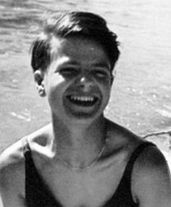 I read practically a book a day in my pre- and early-teen years, and I liked nothing more than a chilling adventure story that kept me reading well past my bedtime.
I read practically a book a day in my pre- and early-teen years, and I liked nothing more than a chilling adventure story that kept me reading well past my bedtime.
The White Rose was such a story, though it was not fiction, as were most books I read. When I reached the last chapter and young Sophie and her brother Hans were executed in, I was caught by complete surprise. Nothing in my short life had prepared me for Hitler.
 The siblings, 21-yr-old Sophie and 24-year-old Hans printed and distributed literature denouncing Hitler and the Nazi government. The pamphlets called on Germans to "cast off the cloak of indifference" and engage in passive resistance to topple the regime.
The siblings, 21-yr-old Sophie and 24-year-old Hans printed and distributed literature denouncing Hitler and the Nazi government. The pamphlets called on Germans to "cast off the cloak of indifference" and engage in passive resistance to topple the regime.
Hans and his friends when out at night and painted slogans on buildings at the university they attended: Hitler the Mass Murderer and Freedom! This photo shows the group at the Munich railway station in 1942, the summer before they were arrested and put to death. Sophie is behind the fence, Hans in the center facing the camera, Christoph Probst to the fore, and Alexander Schmorell and Willi Graf to the right.
This photo shows the group at the Munich railway station in 1942, the summer before they were arrested and put to death. Sophie is behind the fence, Hans in the center facing the camera, Christoph Probst to the fore, and Alexander Schmorell and Willi Graf to the right.
Since I rediscovered Sophie's story in the book Women Heroes of World War II, by Kathryn J. Atwood, I've had a sick-to-my-stomach feeling of fear and dread off and on, as well as finding myself close to tears in unguarded moments.
As my childhood experience of this story revisited me, I realized I had often measured myself against Sophie. Holding my whiny self up to her light, I always fell short. Below, Sophie Scholl's mug shots.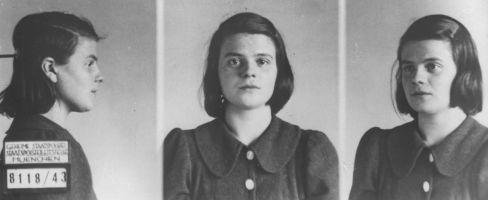
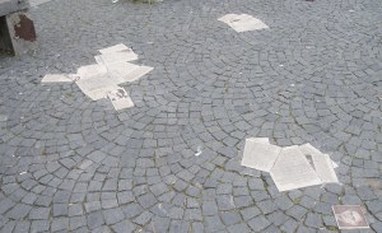 Memorial in Munich
Memorial in Munich
When I first came across Fannie Sellins’ story, (which is now my forthcoming book) the title of the article was In the Midst of Terror, She Went Out to Her Work. I pursued details as if they were an antidote to my fatal condition. How had Fannie found the courage to go out on the picket line day after day when violent men had threatened to kill her?
When I discovered the American military nurses that had been captured POW by the Japanese in WWII, (the subject of Pure Grit) I went on a mad search of the internet for details. I ordered every book I could find had been written about them. How had these women survived starvation, sickness, isolation for three long years in captivity? How had they kept courage when day 930 in prison camp turned into day 931.
As a girl, I could imagine myself bravely printing forbidden pamphlets to protest an unfair government. But I only identified with Sophie to a point. I did not have the courage to risk my life like she did.
Sophie’s conviction never left her. She and Hans were executed three hours after their sentencing for treason. The prison guards reported: “They were led off, the girl first, she went without the flicker of an eyelash. None of us understood how this was possible. The executioner said he had never seen anyone meet his end as she did."
Sophie told her cell mate the day before her death, "It is such a splendid, sunny day, and I have to go. But how many have to die on the battlefield in these days, how many young promising lives... What does my death matter if by our acts thousands of people are warned and alerted."
Today, I am not measuring myself against Sophie's courage. I'm accepting myself for who I am, and I'm freer to see Sophie more clearly, too.
When her story is no longer tinged with my self-judgement, I have greater capacity to be inspired by her integrity, to marvel at her valor, and to believe in our human ability to act with virtue in depraved and brutal circumstances.
Any thoughts? I'd love to hear from you. Leave your comment below.
 I stumbled upon a live wire stretching back to my childhood and the shock and horror of that particular story surged up to the present, as fresh as the day I first felt it.
I stumbled upon a live wire stretching back to my childhood and the shock and horror of that particular story surged up to the present, as fresh as the day I first felt it.For many, it's The Diary of Anne Frank that brings Nazi Germany up close and personal for the first time. For me, it was The White Rose and Sophie Scholl. Sophie set the standard for courage, both consciously and unconsciously throughout my life.
 I read practically a book a day in my pre- and early-teen years, and I liked nothing more than a chilling adventure story that kept me reading well past my bedtime.
I read practically a book a day in my pre- and early-teen years, and I liked nothing more than a chilling adventure story that kept me reading well past my bedtime.The White Rose was such a story, though it was not fiction, as were most books I read. When I reached the last chapter and young Sophie and her brother Hans were executed in, I was caught by complete surprise. Nothing in my short life had prepared me for Hitler.

 The siblings, 21-yr-old Sophie and 24-year-old Hans printed and distributed literature denouncing Hitler and the Nazi government. The pamphlets called on Germans to "cast off the cloak of indifference" and engage in passive resistance to topple the regime.
The siblings, 21-yr-old Sophie and 24-year-old Hans printed and distributed literature denouncing Hitler and the Nazi government. The pamphlets called on Germans to "cast off the cloak of indifference" and engage in passive resistance to topple the regime. Hans and his friends when out at night and painted slogans on buildings at the university they attended: Hitler the Mass Murderer and Freedom!
 This photo shows the group at the Munich railway station in 1942, the summer before they were arrested and put to death. Sophie is behind the fence, Hans in the center facing the camera, Christoph Probst to the fore, and Alexander Schmorell and Willi Graf to the right.
This photo shows the group at the Munich railway station in 1942, the summer before they were arrested and put to death. Sophie is behind the fence, Hans in the center facing the camera, Christoph Probst to the fore, and Alexander Schmorell and Willi Graf to the right. Since I rediscovered Sophie's story in the book Women Heroes of World War II, by Kathryn J. Atwood, I've had a sick-to-my-stomach feeling of fear and dread off and on, as well as finding myself close to tears in unguarded moments.
As my childhood experience of this story revisited me, I realized I had often measured myself against Sophie. Holding my whiny self up to her light, I always fell short. Below, Sophie Scholl's mug shots.

 Memorial in Munich
Memorial in Munich When I first came across Fannie Sellins’ story, (which is now my forthcoming book) the title of the article was In the Midst of Terror, She Went Out to Her Work. I pursued details as if they were an antidote to my fatal condition. How had Fannie found the courage to go out on the picket line day after day when violent men had threatened to kill her?
When I discovered the American military nurses that had been captured POW by the Japanese in WWII, (the subject of Pure Grit) I went on a mad search of the internet for details. I ordered every book I could find had been written about them. How had these women survived starvation, sickness, isolation for three long years in captivity? How had they kept courage when day 930 in prison camp turned into day 931.
As a girl, I could imagine myself bravely printing forbidden pamphlets to protest an unfair government. But I only identified with Sophie to a point. I did not have the courage to risk my life like she did.
Sophie’s conviction never left her. She and Hans were executed three hours after their sentencing for treason. The prison guards reported: “They were led off, the girl first, she went without the flicker of an eyelash. None of us understood how this was possible. The executioner said he had never seen anyone meet his end as she did."
Sophie told her cell mate the day before her death, "It is such a splendid, sunny day, and I have to go. But how many have to die on the battlefield in these days, how many young promising lives... What does my death matter if by our acts thousands of people are warned and alerted."
Today, I am not measuring myself against Sophie's courage. I'm accepting myself for who I am, and I'm freer to see Sophie more clearly, too.
When her story is no longer tinged with my self-judgement, I have greater capacity to be inspired by her integrity, to marvel at her valor, and to believe in our human ability to act with virtue in depraved and brutal circumstances.
Any thoughts? I'd love to hear from you. Leave your comment below.
Published on October 02, 2015 02:00



